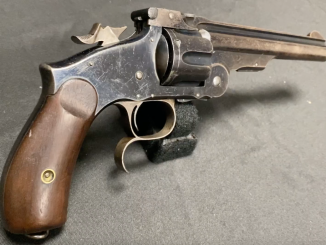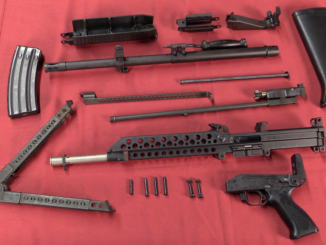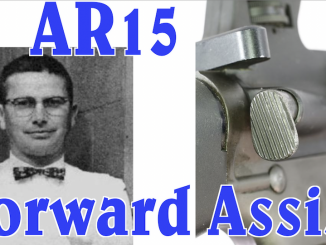William McCarty patented this turret revolver design in 1909 (submitted in 1908, approved in 1909), with the idea of making a high capacity revolver. His gun held 18 rounds of .22 rimfire ammunition – double the typical .22 revolver capacity. He did that by making a vertical turret system with a large ring to hold the 18 rounds, which in turn made the gun pretty bulky. I had a reader send me a copy of his patent back in 2013, and at the time I didn’t know that one had ever been actually made. Well, there was one – it’s here and also documented in Louis Winant’s book “Firearms Curiosa”. Not surprisingly, the design never made it into mass production…
Related Articles

Revolver
The S&W No.3 Russian Model Made at Tula in Russia
This is lot #3124 in the upcoming RIA Premier Auction. It was scheduled for April, but has been postponed – check their web site for upcoming Online Only auctions every month, though! The Russian government […]

Light MGs
Stoner 63A Automatic Rifle – The Original Modular Weapon
The Stoner 63 was a remarkably advanced and clever modular firearm designed by Eugene Stoner (along with Bob Fremont and Jim Sullivan) after he left Armalite. The was tested by DARPA and the uS Marine […]

Commentary
Saga of the AR15 Forward Assist: A Solution Searching for a Problem
In 1963, the US Army set out to purchase 85,000 AR-15 rifles as a one-time procurement to hold the infantry through until final adoption of the expected Project SPIW rifle. Where the previous Air Force […]

Gag me, this is a bad idea! I can’t understand how anyone could carry this monster in a jacket pocket. The arrangement looks more like a pan magazine but as we know, pans are too bulky for your pocket. A charger-loaded pistol or even the zigzag revolvers would do better… I could be wrong.
“patented”
US Patent number 913756 A revolver available here:
https://patents.google.com/patent/US913756
When indeed peculiar, I suspect it might be response to automatic pistols, as this weapon is flat (less thick that 18-shot .22 rim-fire revolver would be), yet as being revolver it can’t have problem of feeding which can be encountered in automatic pistol of that era (failure to feed cartridge into chamber) and can use (then) easily available – keep in mind that time black-powder .22 rim-fire were still widely distributed and in 1900 in U.S. there was not automatic pistol for that cartridge readily available if I am not mistaken.
Citing that patent this weapon is
novel form of revolver which is peculiarly designed so as to enable a comparatively large number of cartridges to be fired in rapid succession.
The object of the invention is to provide a revolver of this character which is of compact and light construction and comprises few and durable parts which will successfully withstand the hard usage to which such devices are subjected.
Also according to http://www.historicalfirearms.info/post/172185989469/mccarty-patent-revolving-pistol-william-b
only known sample differ from patent by fact that whole cylinder (ring?) is removed reloading rather than loaded one-by-one. First one seems better as it allow changing depleted cylinder (ring) for fresh one with loaded cartridge – much faster than loading one-by-one.
Sounds like changing ammunition pans on the Lewis gun and similar weapons.
I want to note while revolver are often associated with swing-out cylinder or top-break reloading there existed and were sold revolvers of so-called pull-pin loading. One example is H&R Model 923, see photos: http://xavierthoughts.blogspot.com/2006/03/hr-923-range-report.html
Seeing it in Winant’s book, I thought it was larger than it is. It’s still a clumsy thing to try to hold and aim.
More-or-less by accident, it duplicates the “low bore line” design of recent revolvers like the Mateba and Chiappa Rhino. This design with a conventional cylinder was proposed back in the 1980s for police revolvers as an aid in rapid-fire instinctive shooting by reducing muzzle flip.
One serious problem I see is the shape of the chamber at the rear. To judge from the chambering shoulder, the beveled section leaves the center of the case head totally unsupported, and the firing-pin assembly does not seem to have a comparable flat “bolt face” built in.
This would seem to be a recipe for blown case heads, even with black-powder .22s. Not something you want on any weapon.
Technically, it’s an interesting gadget. But not a very practical or even safe defensive sidearm.
About the only “high-capacity revolver”design that ever made much sense was the Darduick revolver. Its three-lobed “rotor” was fed by a box magazine in the butt holding up to 20 rounds. Of course, it didn’t work without the “trounds”, the high-strength acrylic plastic casings for either conventional .38 Special or 9 x 19mm cartridges, or the ones that were basically what we’d call Plastic-Cased Telescoped Ammunition (PCTA) today.
I still say the Dardick system is one worth looking at; if not in handguns, at least in very high fire rate weapons like heavy machine guns and automatic cannon.
cheers
eon
Could a… Liquid/binary Wankel engine, gun: 1. Fuel “Stuff” in, rotate: 2. “Oxidizer” thing… In: 3. Bang out – Drop projectiles in-front of said bang. Work? I like the Dardik think my self, but it still has cases…
Essentially like an engine… But the exhaust, fires the projectiles.
Pair of these Mk108 lark: no empty cases. Maybe, heat exchanger, ammonia to water conversion… Something. Sure there’s a gun there in the Wankel engine, gunpowder engine of ye olde times. BBBBBBBBBB’ANG! 30mm explosive projectiles. Even as a last ditch Rocket fighter armament “unconventional, may explode and destroy piliot/cheap aircraft” type thing. A Wank gun, ha… If it could be mass manufactured, perhaps it would not be so “wank”
” “unconventional, may explode and destroy piliot/cheap aircraft””
Should I understand that as Bachem Ba 349 or something else?
https://en.m.wikipedia.org/wiki/Bachem_Ba_349
Kind of. Your almost an encyclopedia you.
“Kind of. Your almost an encyclopedia you.”
So I assume you need flying apparatus which climb fast, consider this:
https://en.wikipedia.org/wiki/Bereznyak-Isayev_BI-1
(see Powered flights chapter for data about climb rate)
However, if you main aim is zero-length launch, see project ZELL:
http://kingoffuel.com/republic-f-84-thunderjet-zero-length-launch-zell/
I love it so much, thank you.
English Electric Lightning, love those also.
We will need them, again.
In wars, us vs robots or, otherwise… Nobody would sustain, economically the loss… Of very expensive fighters, many would be lost.
Back to basics, air superiority is a must. Even temporarily.
200,000 cheap planes may… One day, delivery victory. Or a, significantly beneficial respite. Millions of dollars down the drain, in real combat now/in the future, WW2/cold war item: would suffer similar casualties to then, robot losses or otherwise. Modern fighters are a luxury, because there is no war.
“Modern fighters are a luxury, because there is no war.”
Then for cheap combat aeroplane see Tomashevich Pegas:
https://modelingmadness.com/review/allies/ussr/cazpegas.htm
“Liquid/binary Wankel engine, gun: 1. Fuel “Stuff” in, rotate: 2. “Oxidizer” thing… In: 3. Bang out – Drop projectiles in-front of said bang. Work? I like the Dardik think my self, but it still has cases…”
I am not what you are requesting, but if weapon which 1 and 2
1) use propulsive liquid instead of powder
2) said liquid is deliver to barrel also AFTER projectile started traveling down the barrel
then see ЖАО, 1st and 2nd photo from top here: https://raigap.livejournal.com/483630.html
it was experimental 14,5 mm gun using PTRD barrel and kerosene + acidum nitricum instead of powder, after test fire against steel plate (effect of which shows 3rd photo from top) it was concluded that impact velocity was no lower than 2000 m/s
Yes. But a Wankel engine. You must think about wanking… Ze vanking of der engine.
Porn hub again. Anyway. Yes novel, approaches, Dardik, etc, “dik” He he.
Meh.
“Dardik, etc, “dik” He he. ”
You are probably mistaking two different ammunition designers:
DAVID DARDICK – designer of TROUND ammunition
DICK CASULL – designer of .454 Casull rimmed metallic center-fire cartridge
https://en.m.wikipedia.org/wiki/Wankel_engine
https://en.m.wikipedia.org/wiki/Gunpowder_engine
We must be able to cross them and make a gun. Well, we don’t have to… Just a thought.
Caseless… No? Well fine. Hum, hum. Mc McCartys peculiar revolver, was, like… Peculiar.
Mr the Mc “Correction.”
Wankel engine feature is that there is not forward-backward movement of piston as in more classic engines, but rather rotation. Aim of weapon is to induce first type of movement (although only forward, without backward) to projectile, so second seems less suitable, unless you are looking for centrifugal gun.
Yes… But the exhaust “I accept you know more than me” but, cross the link you posted with a Wankel engine- And the exhaust is the barrel. Feed of projectiles, separate.
“Caseless… No? Well fine. Hum, hum. Mc McCartys peculiar revolver, was, like… Peculiar.”
Though, it should be noted that generally revolver should be case-less friendly weapon, as there is not mechanism ramming cartridge into chambers or real danger of cook-off, on the other hand case-less revolver of classic type would have little advantage over that using metallic cartridges
He he!
“He”
Helium (ELEMENT No. 2) is used in NASA Light-gas gun:
https://en.wikipedia.org/wiki/Light-gas_gun
which is used to investigate impacts of high velocity, but it is another principle.
You have white rabbit? With Mad hatter, in Alice und vonderlanden weeee.
I think you forgot about the March Hare.
All good, Easter.
“You have white rabbit? With Mad hatter, in Alice und vonderlanden weeee.”
Considering low convergence of your statements and unable to detect pattern I must ask you:
Are you follower of Pure Form Concept of Witkacy?
http://segr-did2.fmag.unict.it/~polphil/polphil/Witk/Witk.html
Witkacy (1885-1939) was Polish writer and I see some common things in your statement and his works.
“About the only “high-capacity revolver”design that ever made much sense was the Darduick revolver.”
I would also point to HDH revolver:
http://guns.wikia.com/wiki/HDH_revolver
which was available with capacity 20 (6,35 mm Browning[.25 Auto] or Velo-Dog cartridge) or 16 (7,65 mm Browning[.32 Auto])
Assuming that showed is .25 Auto version then diameter of chamber is around 7 mm in diameter, so I estimate diameter of cylinder to be around 58 mm.
People are cheaper than machines. If machines can’t defend themselves against shaped charges “they’ve had it” anti shaped charge tech, is anti human: Everyone should ponder counter measures against it, for future use, now. Shooting one with an AR won’t work.
If you don’t understand what I mean, they are trying to invent ways to disrupt the plasma emitted by shaped charges, in “fancy” multimillion dollar scientific ways. It isn’t to protect us, in armoured fighting vehicle’s. It’s to protect them: The machines.
For your information:
system to protect AFV from incoming missiles (including that with HEAT warhead) were developed and used in reality, see Kompleks 1030M-01
https://en.wikipedia.org/wiki/Drozd
Going back to my remarks on the Dardick, it could be a useful system for a high-fire-rate cannon because the “trounds” could be moulded as an integral part of a feed belt.
The belt itself would thus ride the outer “wall” of the Dardick chamber setup, and as each round was fired it would simply be pulled out to the side as the belt moved over one “space” with each segment of rotation of the Dardick rotor. Please note that while Dardick rotors traditionally have three lobes, this was due to a desire for compactness in a handgun or carbine. There’s no reason a Dardick rotor in a cannon could not have four, five, or six “chambers”, as with the ADEN or DEFA revolver-breech systems.
The major advantage of the Dardick system with an integral belt/tround moulding is that there is no “remove cartridge from belt/ram cartridge/extract cartridge/eject cartridge” sequence in feeding and firing. The next tround up is lined up, fired, and moved on out as the tround after it is ready to fire. This alone should effectively increase the RoF of such a cannon by roughly 25%, or in the case of a DEFA 30mm form ~1,200 r/m to ~1,500.
Applied to a Gatling type weapon, a 20mm that normally fires at 6,000 r/m could easily achieve 8,000. The limiting factor would be barrel heating.
NB; By the nature of is structure, the Dardick tround lends itself very well to the use of liquid propellant. Each tround is essentially a plastic “bottle” with the projectile for a “stopper”.
For that matter, by judicious manipulation of the chemical structure of the plastic, it could be made combustible, with sufficient “lag time” relative to propellant combustion (I’m talking nanoseconds here) to achieve effective breech seal followed by casing combustion, resulting in an even higher RoF plus probable additional MV as the casing’s combustion adds to the propellant’s.
A Very High Rate of Fire (VHRF) Combustible Plastic-Cased Telescoped Ammunition (CPCTA) weapon like this would seem to be nearly the ideal weapon for Forward Area Air Defense (FAAD).
Lasers are the ideal, of course, but at the present SOTA they tend to be expensive, fragile, and require serious power supplies, hence the Navy’s interest in them. (They work very well on major surface combatants, where none of the above is an issue.)
For an army in the field, seeking to protect its mechanized units from tactical airpower, drones or even cruise missiles, something like a 25mm Dardick mounted on an MBT chassis, and firing at 12,000 to 18,000 r/m in quarter-second bursts (“only” 50 to 75 rounds per burst!), could be a very practical addition to the artillery train.
The German Army could call it the “Gepard II”.
😉
cheers
eon
Russia is in 1987 mode listening to Slayer. All this laser “gumpf” is no good; heat someones MRE in Kandahar from L.A in 14 hrs. tactical nukes now!
“Nothing against them, just saying.” Furburgers out there in the snow, practicing incest like in Utah or whatever” Coming over here being poisoned by our shitty beer. Deport.
“Slayer(…)Kandahar”
???
Actually this song https://www.youtube.com/watch?v=71HdA-vxLEg
author is Александр Першко – Балев
So this could be comparable to a MetalStorm system but using liquid “propellant” thus having a quicker “reload” for firing again?
Just thinking out loud.
https://m.youtube.com/watch?v=lprk1SBBqB0
“Who me? Thank you very much.”
Very similar in effect to MetalStorm. But since each round would have the full “travel” of the barrel, it would have the consistency in accuracy and velocity that MetalStorm lacks, which is one of the major reasons it’s never reached the point of an actual usable weapon system.
Liquid propellant would work in a “conventional” Dardick system just as well as any standard propellant powder. It could also be used in a combustible-case version, which would otherwise probably use a monolithic-grain solid propellant (not unlike a solid rocket motor).
The Dardick “tround” would seem to solve most of the problems of liquid-propellant gun technology, as well as those of “caseless” type ammunition. Not to mention being easier to handle in very high feed rate systems than a conventional cartridge format.
According to Chinn (Vol. 3), the major stumbling block of high-fire-rate weapon design has always been the metallic cartridge itself, which for the most part was designed for manually-repeating or at most semi-automatic weapons, neither of which were readily adaptable to feed systems capable of “keeping up” with a “high-speed” fire rate weapon.
The metallic cartridge has been with us longer than most people think; experiments with steel ones in what we would recognize as a Snider-type single-shot breech go back to the 16th Century and matchlock ignition.
The metallic cartridge has had a fair run, especially in the last century and a half. But now it’s time to think outside of that particular box.
The Dardick system, itself a half-century old, may be the lowest-risk way of accomplishing that.
cheers
eon
“The Dardick system, itself a half-century old, may be the lowest-risk way of accomplishing that.”
There exist similarly aged concept of folded ammunition, see photos: https://forums.spacebattles.com/threads/folded-ammunition-of-the-1970s.313586/
it provide shorter overall cartridge length than classic cartridge of equivalent powder charge, so it might be useful for high Rate-of-Fire weapons.
“The belt itself would thus ride the outer “wall” of the Dardick chamber setup, and as each round was fired it would simply be pulled out to the side as the belt moved over one “space” with each segment of rotation of the Dardick rotor”
Weapon working on similar principle, but with normal cartridge was build in tested during Great War – namely Fokker-Leimberger: http://guns.wikia.com/wiki/Fokker-Leimberger
“12,000 to 18,000 r/m”
In fact there existed experimental TRW HIVAP weapon using tround ammunition:
https://raigap.livejournal.com/248125.html
which fired 30000 rpm.
Developed in 1967-1970, firing in same moment from 2 barrels, throwing 35 grain flechette (smooth-bore barrels) at 1370 m/s. Maximal calculated rate-of-fire 42000, however if it is too low for you, there was option of replacing normal primer with electric, which would allow to get 60000 rpm. There was developed box of ammunition with capacity 6000.
This gun is proof that some early twentieth century people smoked a LOT of weed.
The comment thread proves the same for our time.
I would rather said it is search for principally new solution, which will have not disadvantages of existing or due to lack of possibility of further improving of existing systems.
The rotating chambers disign is similar to one used on the palm gun “Le Protector”.
Actually “Le Protector” is refered as “Palm Pistol” although it is a revolver.
https://en.wikipedia.org/wiki/Protector_Palm_Pistol